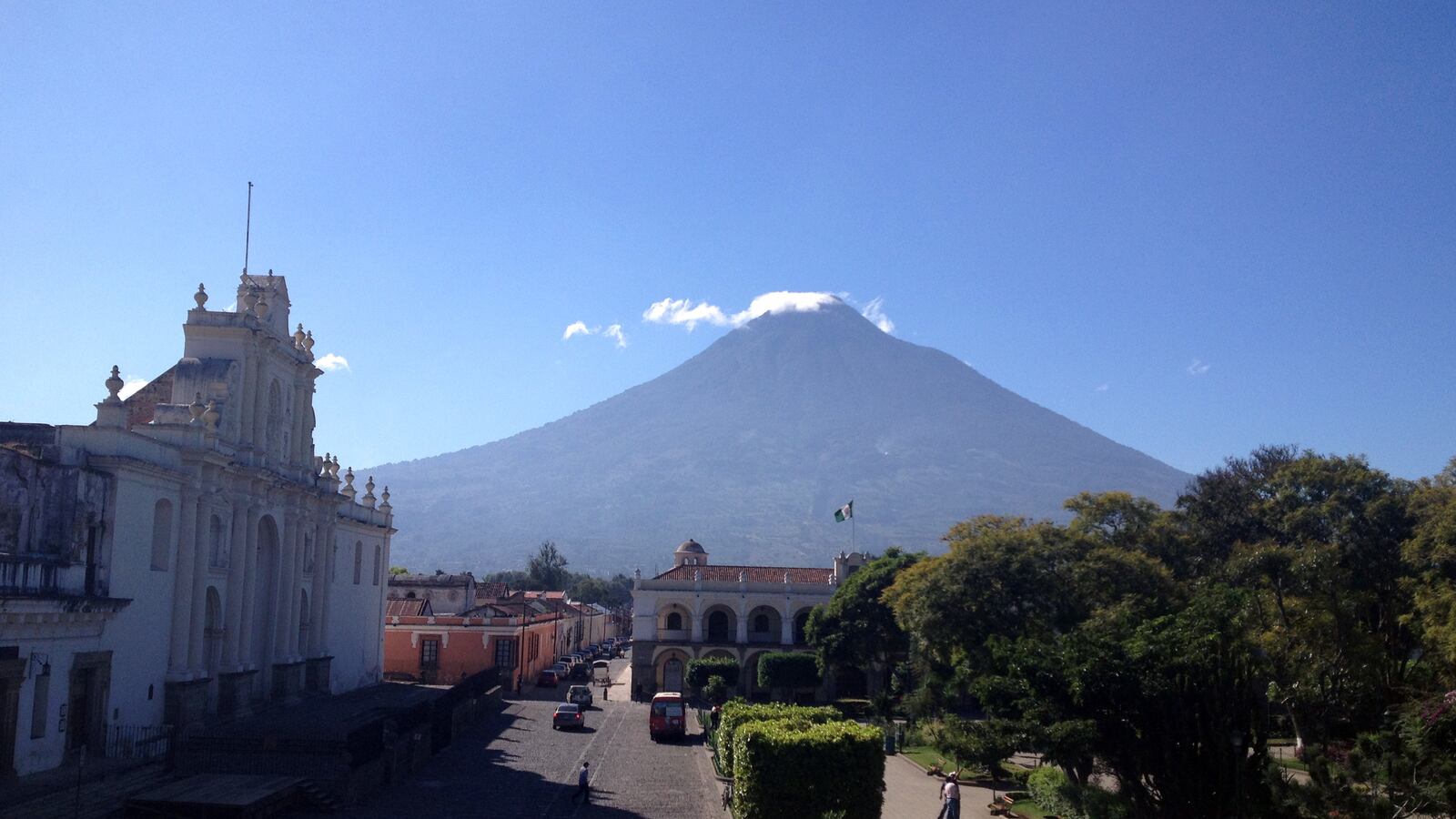The bobos in the group could not have looked more vindicated.
We are touring a coffee plantation in Antigua Guatemala, and the tour guide has just revealed that the beans tossed aside due to contamination by driller bugs are then sold to make instant coffee. That’s right, the coffee you make in the machine at work.
Nestled in a valley between volcanoes (some of which are still active) just an hour from Guatemala City, Antigua with all its history, beauty, and temperate climate has been relatively insulated from the tourist boom and should make every vacation shortlist after this painfully cold winter.
Founded as Santiago de los Cabelleros in 1543, Antigua was the capital of the Spanish colony of Guatemala, which covered most of Central America. In 1773, it was abandoned after a series of earthquakes left much of the city in ruins. Its name was changed to Antigua Guatemala (old Guatemala), and while some people remained, residents of the new capital, Guatemala City, often pilfered the ruins of its great buildings. Over the centuries, it has gradually made a comeback, first with coffee in the late 1800’s, and then in the mid-20th century with Spanish language schools.
One of the best ways to get to know the town is on a walking tour with Elizabeth Bell. During the half-day jaunt, Bell takes tourists through some of the city’s most important architectural gems and significant sites. But the best part of her tour is the artwork she points out along the way, from a corn-husk sculpture of Christ in the San Francisco Church (which also houses the tomb of Central America’s first saint, Hermano Pedro) to the Museums Promenade at the Casa Santo Domingo, which features well-preserved colonial art along with contemporary artists.
While Italian food in Guatemala may not seem like the most logical choice, Caffe Mediterraneo is the perfect stop for carbo loading after a morning of walking (the antipasti is delicious, especially paired with a nice cold Gallo). It’s not hard to find Antigua’s other great bars and restaurants just by wandering around at night, but there are two relatively obscure spots not to miss. Start the day off with a fresh smoothie and other tasty fare from Vivero y Café de la Escalonia, which is set in a plant nursery just a few blocks away from the noise of 5 Avenida. For dinner, Hector’s, near La Merced, features a delicious menu that changes constantly.
For a day of shopping, just wander down the Avenue of the Arch, which cuts through the central square, is cleared of car traffic on weekends, and features some of the more alluring buildings and shops in the city. Guatemala is known for its textiles, and one of the best places to find quality wares is Colibrí, a cooperative founded in 1984 to assist indigenous women widowed during the country’s civil war. The quaint little shop has a range of phantasmagoric linens, tablecloths, and blankets. For cheaper, and arguably more fun, items head to the artisan’s market next to the ruins of the Iglesias del Carmen, where you will find a variety of masks, psychedelic clothing, and a hodgepodge of other items. Jade has played an important role in Mayan and Gautemalan history, and the SA Jade Factory is a good place to find the local product (which is different from the jade in ancient China). Jade was a valuable gemstone in Mayan tradition; Mayan ruler Pakal’s jade death mask is one of the most famous artifacts from that time period.

For a different side of Antigua’s culture, spend an afternoon exploring the truly breathtaking ruins of its various churches. From the main cathedral in the central square, which is still largely in ruins, to the beautiful Iglesias del Carmen (my favorite) and Iglesia San José El Viejo (which seems to host a huge wedding party every night), these colonial remnants give a whole new meaning to ruin porn.
Perhaps the most famous however, is the former Convento y Templo de Santo Domingo, which is now the Hotel Casa di Santo Domingo. A former monastery and cathedral, it was destroyed and partially buried after being abandoned. When restoration began, it was decided that large parts of the ruins, including the cathedral, which is now open-air, would remain intact, creating a public space that leaves the sensation of a time warp.
But don’t get too distracted by the food, shopping, and sightseeing in Antigua that you forget to go outside the city.

“It might just be the most perfect volcano,” said one member of our group as we cruised along Lake Atitlán in the early morning hours.
And while his casual observation set off a debate among the well-traveled group, in that moment, the sentiment was spot on. Volcan San Pedro is a colossal beauty that spectacularly rises from the southern shore of Lake Atitlán and is topped with a seemingly permanent swirl of clouds. The lake, deemed by some to be the most beautiful in the world, is roughly three hours from Antigua via winding (and I mean winding) roads. One of the best ways to see the pristine lake is to rent a tourism boat from Panajachel and enjoy the view from the San Juan de la Laguna on the southern side.
While in the area, also arrange for a village tour to experience the culture of the local Tz’utujil Mayan people. See their beautiful murals and textiles created using a natural dye process, experience their historic traditions, and learn about some of the troubles the villages face from environmental disasters like Hurricane Katrina. On your way back across the lake, stop at the Laguna Lodge for lunch with unparalleled views.
Another great day trip is to hike the Volcan Pacaya, a menacing, and very active volcano towering over the suburbs of Guatemala City. While not a particularly arduous hike (although the dozens of horses available for hire might make you think otherwise), those who make the journey get to traverse a Mordor-like landscape, with swirling mist and volcanic ash, and even roast marshmallows in pockets still hot from lava flows as recent as August 2013. At the highest point one can safely climb, hikers can look out and see the Pacific Ocean in one direction and the vestiges of the powerful eruption in 2010 (which killed a journalist due to giant rocks being shot out of the volcano’s mouth) in the other, with the hardened, grey lava flows stopping just shy of the villages.
Then there is the most famous Guatemalan day trip – Tikal. One of the largest sites of pre-Columbian Mayan ruins, Tikal was once one of the most important cities in the Mayan world. With gigantic temples (Temple IV is over 200 feet) and nowhere near the crowds of Mexico’s Chichen Itza, visitors can get a sense of the Mayan culture and, from some ruins left covered by jungle, the state of the ruins when they were found. It is not particularly easy to get from Antigua to Tikal—take an early morning flight to Flores, then a bus to Tikal, and then do it all over again on the way back—but doing it in a day is a good option if staying overnight in a jungle doesn’t appeal to you.
While Guatemala still faces widespread crime and violence, largely due to the drug trade, Antigua has been and still is seen as untouched by most of the problems haunting this beautiful country. And perhaps because of the country’s reputation, walking around Antigua still has the added bonus of feeling like you’ve discovered a cool place few Americans know. So, next winter, skip Punta Cana and Cancun, and head to Antigua.






